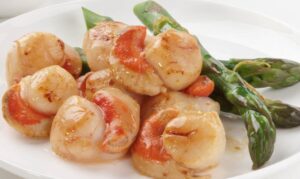Frozen seafood specials allow restaurants to offer their customers a wider variety of fish and seafood species year-round. This reduces food waste and will enable chefs to prioritize local species in the low season.
Ensure the frozen seafood you purchase is quickly “flash-frozen” and not slowly or thawed and refrozen. The “flash-frozen” process rapidly chills seafood below freezing temperatures to arrest nutrient deterioration and stop ice crystal formation that damages cell walls. For more frozen seafood specials, check this out.
Seafood Casseroles
 This seafood casserole is a crowd-pleaser that’s easy to prepare, making it an excellent weeknight dinner option when you see reasonable prices for fresh seafood at your local fish market. While shrimp, lobster and crabmeat give the dish its signature coastal New England flavours, it can easily be made without those items to keep costs down even more.
This seafood casserole is a crowd-pleaser that’s easy to prepare, making it an excellent weeknight dinner option when you see reasonable prices for fresh seafood at your local fish market. While shrimp, lobster and crabmeat give the dish its signature coastal New England flavours, it can easily be made without those items to keep costs down even more.
The creamy sauce is made by creating a roux with butter and flour and adding some reserved cooking water and milk, cream cheese, dill, thyme, and pepper. The dish’s uncooked shellfish mix (cod, clams and mussels are also available frozen) is nestled between the other ingredients, and then a topping of breadcrumbs and butter is sprinkled over the top to create a golden-brown crust. This dish can be baked and served immediately or stored in the refrigerator for up to two days or in the freezer for up to three months.
Seafood Salads
Seafood salads have long been a staple at delis and on salad bars. They can be made with fish and shellfish, such as tuna, salmon, cod, or scallops. They are usually combined with fresh vegetables like carrots, fennel, tomatoes, cucumbers, or red onions. You can add healthy fats like pistachios or feta cheese to give your salads more texture and flavour. For more frozen seafood specials, check this out.
Seafood salads are generally high in protein, vitamins, and minerals and low in calories. They are also a great source of Omega-3 fatty acids, which can help with heart health and brain development.
Seafood Soups
Seafood soups are hearty and comforting, making an excellent meal for a cold day. You can find seafood soup recipes that use a mix of shrimp, clams and fish or lobster for an exotic twist or more traditional recipes with classics like clam chowder and lobster bisque.
These soups also nourish the body, containing herbs, spices, lean protein, vitamins, and minerals. For example, a serving of clam chowder contains protein, selenium, potassium, iodine, vitamin B complex and calcium.
Another option for seafood soup is a bowl of cioppino, a tomato-based dish from San Francisco that features a delicious combination of Dungeness crab, mussels, clams, and shrimp. This seafood stew is an elegant and delightful choice for special occasions, romantic dinners, or anniversary celebrations at home. Serve with simple arugula, parmesan salad, and hunks of crusty bread on the side for a complete meal. Adding parsley sprigs to the broth will provide an earthy and fresh flavour.
Seafood Wraps
Salmon is a fast-cooking fish, making it ideal for these quick and easy lunch or dinner wraps. Add a crunchy salad, fresh leafy greens, and a healthy sauce for a complete meal in under 20 minutes.
A bonus to using frozen seafood is that it’s typically cheaper than fresh fish. It also has a lower carbon footprint than many meat proteins because it is sustainably sourced and frozen at an appropriate temperature to preserve its quality. For more frozen seafood specials, check this out.
Seafood should always be handled, prepped, and stored correctly. This will help prevent cross-contamination with other foods and the growth of illness-causing bacteria. When buying cooked seafood, ensure it’s separated from the raw product and refrigerated within two houre. If you purchase unpackaged seafood, look for time/temperature indicators on the packaging to ensure that it has been kept at the proper refrigerator temperature. If not, ask to see the raw product before purchasing.
Fresh and Frozen Seafood Specials
Fresh seafood specials are the perfect ingredient for various menu items. Crustaceans like shrimp are ideal for all seasons, from a cold summer cocktail to a warming winter shrimp scampi.
Frozen seafood also offers less waste than fresh as it can be frozen on the boat and stored until needed. Plus, purchasing frozen reduces the earth’s carbon footprint, reducing the need for air freighting.